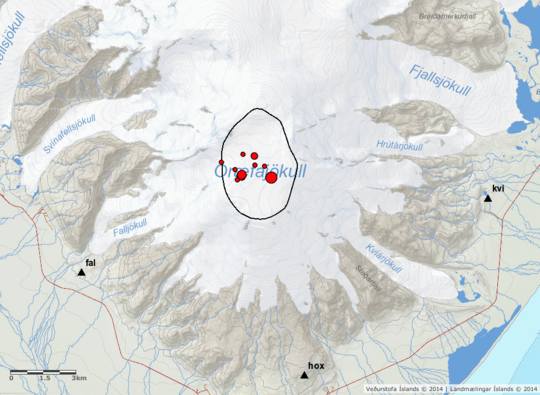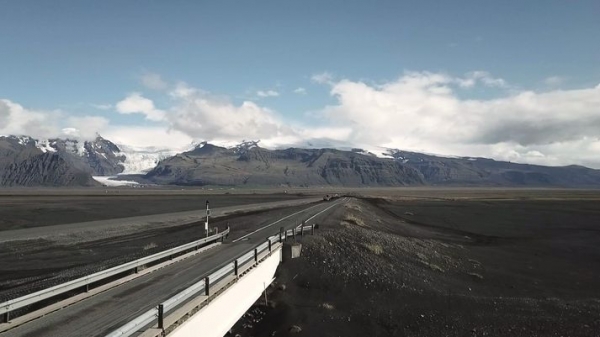It seems fitting that Iceland's tallest peak also one of the deadliest volcanoes of Iceland. Öræfajökull is one of two major volcanoes hidden beneath Vatnajökull glacier which have shown growing activity in recent months. The other, Bárðarbunga, located beneath the NW part of the glacier, has also been showing growing signs of activity since it erupted in the 2014-15 Holuhraun eruption.
Read more: Quick primer on Bárðarbunga, Iceland's most powerful volcano
Both are among the most powerful and dangerous volcanoes in Iceland. Unlike Bárðarbunga, which has historically shown relatively high levels of activity Öræfajökull has been completely dormant for 250 years. In 2017 the volcano began stirring again.
Iceland's tallest peak

The tallest peak in Öræfajökull is Hvannadalshnjúkur peak, standing at 2,110 m (6,921 ft) above sea-level, Hvannadalshnjúkur is a peak in the NW part of the ridge surrounding the volcano's crater. Note that the volcano and glacier share the same name, Öræfajökull.
The volcano is covered with an ice cap which forms the southernmost part of Vatnajökull glacier. Öræfajökull glacier has several outlet glaciers, including Svínafellsjökull and Fjallsjökull who empty into two of the most popular glacial lagoons in Iceland.
Dormant for more than 250 years
Öræfajökull is believed to erupt once every few hundred years. It has erupted twice since Iceland was settled in the 9th century. A massive eruption in 1362 and a second smaller eruption in 1727. The 1362 eruption is the second deadliest eruption in Icelandic history, following the 1783-1784 Lakagígar eruption.

Öræfajökull erupts in giant steam-blast eruptions, also known as phreatic or ultravolcanian eruption, similar to the 1883 Krakatoa eruption. Steam-blast eruptions occur when magma heats ground water, creating a near-instantaneous evaporation and explosion which can eject enormous quantities of ash, rock and volcanic material which is then deposited over surrounding areas.
The Glacier of the Wasteland
The exact death toll in the 1362 Öræfajökull eruption is not known. It destroyed one of the most prosperous farmland regions in South Iceland, killing all inhabitants and livestock at 20-40 farms in the volcano's foothills. Following the eruption, which deposited 10 cubic kilometers of volcanic material over fields and farms in the region, the region's name was changed to Öræfi, which translates as Wasteland in modern Icelandic.
The 1362 eruption is considered to be the largest tepthra eruption in the world in the last 1000 years.
It is clear, however, that it is dwarfed by Lakagígar when ca. 10,000 people (20% of the Icelandic population at the time) and 60-80% of all livestock died. The Lakagígar eruption was also responsible for a cooling of the temperature in the northern hemisphere and harvest failures in Europe which are believed to have killed millions more.
Waking up from a slumber

The volcano is believed to have been completely dormant between the 1727 eruption and the current wave of activity when began last year. Since then the volcano has been showing signs of growing activity which is caused by magma thrusting its way to the surface. Geothermal activity in the caldera has also been growing, creating a deep cauldron in the ice cap.
Read more: Magma movements in Öræfajökull volcano a clear sign of growing activity
Scientists have been unable to locate exactly where the magma movements are located, but the movement is somewhere in the top six kilometers (3.1 mi) of the crust. The magma movements are still relatively small, significantly smaller than what was seen in the lead up to the 2010 Eyjafjallajökull eruption. However, it is large enough to cause the creation of a new powerful geothermal area in the volcano's caldera, capable of melting deep cauldrons in the ice cap.
Páll Einarsson, a geophysicist with the Icelandic Meteorological Office told the local newspaper Morgunblaðið in April that the tremors have been relatively minor, but they point to significant activity in the volcano, and are most likely caused by magma movements. The relatively small tremors are also notable because the volcano has historically been very quiet. They are a clear sign something unusual is going on.
The tremors in Öræfajökull and the caldera of the volcano have always been relatively small, so there is very good reason to keep a close eye on the development.
A replay of the Eyjafjallajökull eruption?

Páll stressed that this did not mean an eruption was imminent. Volcanoes move very slowly, he pointed out, and it can take years, even decades, for a volcano to work itself up into an eruption. He pointed out that the behavior of Öræfajökull now is similar to activity in Eyjafjallajökull volcano in 1998. Twelve years later (in 2010) Eyjafjallajökull finally erupted. This means we might have to wait for a decade for an eruption in Öræfajökull.
Two popular tourist destinations could be affected
Two of Iceland's most popular tourist destinations are located in the foothills of Öræfajökull: Skaftafell visitor center in Vatnajökull National Park and Jökulsárlón glacial lagoon. The Icelandic Civil Protection Agency estimates that it will have a 20 minute warning before any eruption in the glacier.
If the threat of an eruption in Öræfajökull wasn't enough a second major natural disaster is looming at one of its outlet glaciers: Receding glaciers threaten a catastrophic mountain collapse at Svínafellsjökull glacier.
Read more: Popular SE Iceland glacial lagoon a ticking time bomb: Catastrophic mountain collapse looms
In the meantime people traveling in the foothills of Öræfajökull (the region between Skaftafell visitor center in Vatnajökull National Park and Jökulsárlón glacial lagoon) are asked to familiarize themselves with the evacuation plan for the region.
Read more: Emergency evacuation plan in case of eruption in Öræfajökull glacier
It seems fitting that Iceland's tallest peak also one of the deadliest volcanoes of Iceland. Öræfajökull is one of two major volcanoes hidden beneath Vatnajökull glacier which have shown growing activity in recent months. The other, Bárðarbunga, located beneath the NW part of the glacier, has also been showing growing signs of activity since it erupted in the 2014-15 Holuhraun eruption.
Read more: Quick primer on Bárðarbunga, Iceland's most powerful volcano
Both are among the most powerful and dangerous volcanoes in Iceland. Unlike Bárðarbunga, which has historically shown relatively high levels of activity Öræfajökull has been completely dormant for 250 years. In 2017 the volcano began stirring again.
Iceland's tallest peak

The tallest peak in Öræfajökull is Hvannadalshnjúkur peak, standing at 2,110 m (6,921 ft) above sea-level, Hvannadalshnjúkur is a peak in the NW part of the ridge surrounding the volcano's crater. Note that the volcano and glacier share the same name, Öræfajökull.
The volcano is covered with an ice cap which forms the southernmost part of Vatnajökull glacier. Öræfajökull glacier has several outlet glaciers, including Svínafellsjökull and Fjallsjökull who empty into two of the most popular glacial lagoons in Iceland.
Dormant for more than 250 years
Öræfajökull is believed to erupt once every few hundred years. It has erupted twice since Iceland was settled in the 9th century. A massive eruption in 1362 and a second smaller eruption in 1727. The 1362 eruption is the second deadliest eruption in Icelandic history, following the 1783-1784 Lakagígar eruption.

Öræfajökull erupts in giant steam-blast eruptions, also known as phreatic or ultravolcanian eruption, similar to the 1883 Krakatoa eruption. Steam-blast eruptions occur when magma heats ground water, creating a near-instantaneous evaporation and explosion which can eject enormous quantities of ash, rock and volcanic material which is then deposited over surrounding areas.
The Glacier of the Wasteland
The exact death toll in the 1362 Öræfajökull eruption is not known. It destroyed one of the most prosperous farmland regions in South Iceland, killing all inhabitants and livestock at 20-40 farms in the volcano's foothills. Following the eruption, which deposited 10 cubic kilometers of volcanic material over fields and farms in the region, the region's name was changed to Öræfi, which translates as Wasteland in modern Icelandic.
The 1362 eruption is considered to be the largest tepthra eruption in the world in the last 1000 years.
It is clear, however, that it is dwarfed by Lakagígar when ca. 10,000 people (20% of the Icelandic population at the time) and 60-80% of all livestock died. The Lakagígar eruption was also responsible for a cooling of the temperature in the northern hemisphere and harvest failures in Europe which are believed to have killed millions more.
Waking up from a slumber

The volcano is believed to have been completely dormant between the 1727 eruption and the current wave of activity when began last year. Since then the volcano has been showing signs of growing activity which is caused by magma thrusting its way to the surface. Geothermal activity in the caldera has also been growing, creating a deep cauldron in the ice cap.
Read more: Magma movements in Öræfajökull volcano a clear sign of growing activity
Scientists have been unable to locate exactly where the magma movements are located, but the movement is somewhere in the top six kilometers (3.1 mi) of the crust. The magma movements are still relatively small, significantly smaller than what was seen in the lead up to the 2010 Eyjafjallajökull eruption. However, it is large enough to cause the creation of a new powerful geothermal area in the volcano's caldera, capable of melting deep cauldrons in the ice cap.
Páll Einarsson, a geophysicist with the Icelandic Meteorological Office told the local newspaper Morgunblaðið in April that the tremors have been relatively minor, but they point to significant activity in the volcano, and are most likely caused by magma movements. The relatively small tremors are also notable because the volcano has historically been very quiet. They are a clear sign something unusual is going on.
The tremors in Öræfajökull and the caldera of the volcano have always been relatively small, so there is very good reason to keep a close eye on the development.
A replay of the Eyjafjallajökull eruption?

Páll stressed that this did not mean an eruption was imminent. Volcanoes move very slowly, he pointed out, and it can take years, even decades, for a volcano to work itself up into an eruption. He pointed out that the behavior of Öræfajökull now is similar to activity in Eyjafjallajökull volcano in 1998. Twelve years later (in 2010) Eyjafjallajökull finally erupted. This means we might have to wait for a decade for an eruption in Öræfajökull.
Two popular tourist destinations could be affected
Two of Iceland's most popular tourist destinations are located in the foothills of Öræfajökull: Skaftafell visitor center in Vatnajökull National Park and Jökulsárlón glacial lagoon. The Icelandic Civil Protection Agency estimates that it will have a 20 minute warning before any eruption in the glacier.
If the threat of an eruption in Öræfajökull wasn't enough a second major natural disaster is looming at one of its outlet glaciers: Receding glaciers threaten a catastrophic mountain collapse at Svínafellsjökull glacier.
Read more: Popular SE Iceland glacial lagoon a ticking time bomb: Catastrophic mountain collapse looms
In the meantime people traveling in the foothills of Öræfajökull (the region between Skaftafell visitor center in Vatnajökull National Park and Jökulsárlón glacial lagoon) are asked to familiarize themselves with the evacuation plan for the region.
Read more: Emergency evacuation plan in case of eruption in Öræfajökull glacier







